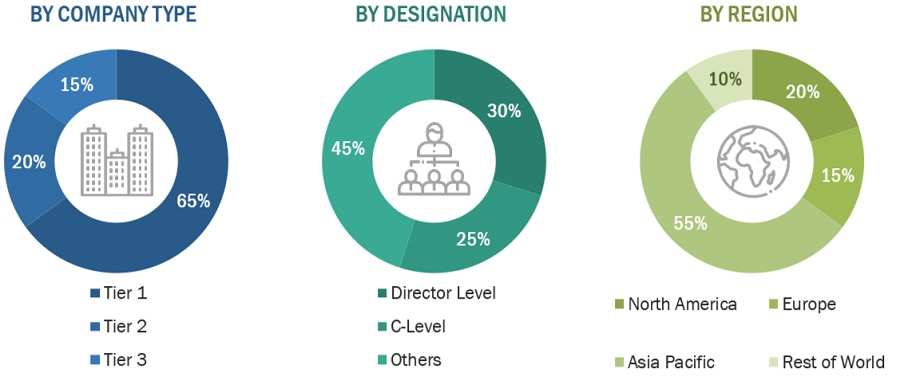The study involved four major activities in estimating the current size of the lithium-ion battery materials market. Exhaustive secondary research was done to collect information on the market, peer markets, and parent market. The next step was to validate these findings, assumptions, and sizing with the industry experts across the lithium-ion battery materials value chain through primary research. Both top-down and bottom-up approaches were employed to estimate the complete market size. Thereafter, market breakdown and data triangulation were used to estimate the market size of segments and subsegments.
Secondary Research
Secondary sources for this research study include annual reports, press releases, and investor presentations of companies; white papers; certified publications; and articles by recognized authors; gold- and silver-standard websites; lithium-ion battery materials manufacturing companies, regulatory bodies, trade directories, and databases. The secondary research was mainly used to obtain key information about the industry’s supply chain, the total pool of key players, market classification, and segmentation according to industry trends to the bottom-most level and regional markets. It has also been used to obtain information about key developments from a market-oriented perspective.
Primary Research
The lithium-ion battery materials market comprises several stakeholders, such as raw material suppliers, technology support providers, lithium-ion battery materials manufacturers, and regulatory organizations in the supply chain. Various primary sources from both the supply and demand sides of the market were interviewed to obtain qualitative and quantitative information. Primary sources from the supply side included industry experts such as Chief Executive Officers (CEOs), vice presidents, marketing directors, technology and innovation directors, and related key executives from various key companies and organizations operating in the lithium-ion battery materials market. Primary sources from the demand side included directors, marketing heads, and purchase managers from various sourcing industries. Following is the breakdown of the primary respondents:

To know about the assumptions considered for the study, download the pdf brochure
Market Size Estimation
Both the top-down and bottom-up approaches have been used to estimate and validate the total size of the lithium-ion battery materials market. These approaches have also been used extensively to estimate the size of various dependent subsegments of the market. The research methodology used to estimate the market size included the following:
The following segments provide details about the overall market size estimation process employed in this study
-
The key players in the market were identified through secondary research.
-
The market shares in the respective regions were identified through primary and secondary research.
-
The value chain and market size of the lithium-ion battery materials market, in terms of value, were determined through primary and secondary research.
-
All percentage shares, splits, and breakdowns were determined using secondary sources and verified through primary sources.
-
All possible parameters that affect the market covered in this research study were accounted for, viewed in extensive detail, verified through primary research, and analyzed to obtain the final quantitative and qualitative data.
-
The research included the study of annual and financial reports of the top market players and interviews with industry experts, such as CEOs, VPs, directors, sales managers, and marketing executives, for key insights, both quantitative and qualitative
Global Lithium-ion battery materials Market Size: Bottom-Up Approach

To know about the assumptions considered for the study, Request for Free Sample Report
Global Lithium-ion battery materials Market Size: Top-Down Approach

Data Triangulation
After arriving at the overall market size using the market size estimation processes as explained above, the market was split into several segments and sub-segments. To complete the overall market engineering process and arrive at the exact statistics of each market segment and subsegment, the data triangulation and market breakdown procedures were employed, wherever applicable. The data was triangulated by studying various factors and trends from both the demand and supply sides in the lithium-ion battery materials sector.
Market Definition
Lithium-ion battery materials refer to the various components and substances used in the construction of lithium-ion batteries. These materials include the cathode and anode materials responsible for storing and releasing lithium ions, the separator that prevents electrical contact between them, the electrolyte that facilitates the movement of ions, and collector foils for electrical connections. These materials, collectively installed and built in the required format, enable the operation of lithium-ion batteries, which are widely used in electronic devices and electric vehicles due to their high energy density and recharging capabilities.
Key Stakeholders
-
Raw material manufacturers
-
Technology support providers
-
Manufacturers of lithium-ion battery materials
-
Traders, distributors, and suppliers
-
Regulatory Bodies and Government Agencies
-
Research & Development (R&D) Institutions
-
End-use Industries
-
Consulting Firms, Trade Associations, and Industry Bodies
-
Investment Banks and Private Equity Firms
Report Objectives
-
To analyze and forecast the market size of lithium-ion battery materials market in terms of value
-
To provide detailed information regarding the major factors (drivers, restraints, challenges, and opportunities) influencing the regional market
-
To analyze and forecast the global lithium-ion battery materials market on the basis of battery type, thickness, type, technology, material, end-use, and region
-
To analyze the opportunities in the market for stakeholders and provide details of a competitive landscape for market leaders
-
To forecast the size of various market segments based on four major regions: North America, Europe, Asia Pacific, and Rest of World, along with their respective key countries
-
To track and analyze the competitive developments, such as acquisitions, partnerships, collaborations, agreements and expansions in the market
-
To strategically profile the key players and comprehensively analyze their market shares and core competencies
Available Customizations
With the given market data, MarketsandMarkets offers customizations according to the client-specific needs.
The following customization options are available for the report:
-
Additional country-level analysis of the lithium-ion battery materials market
-
Profiling of additional market players (up to 5)
Product Analysis
-
Product matrix, which gives a detailed comparison of the product portfolio of each company.



Growth opportunities and latent adjacency in Lithium-ion Battery Materials Market